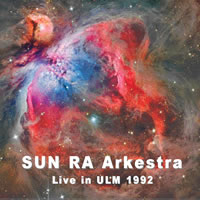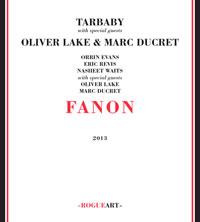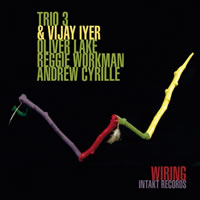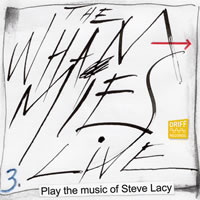Moment's Notice
Reviews of Recent Recordings
(continued)
Sun Ra Arkestra
Live in Ulm 1992
Leo Golden Years of New Jazz 2CD
 Somewhat unexpectedly, here we have a swaggering slice of late Ra, recorded the year of his homegoing. Always on the road, the Arkestra by this point had fully synthesized its affectionate embrace of idiomatic music from distinct periods of “jazz” with its more cosmic orientations. On board for the journey with Ra were trumpeters/vocalists Ahmed Abdullah and Michael Ray, trombonist Tyrone Hill, the indefatigable Marshall Allen on alto and flute, James Jacson (bassoon, flute, oboe, and drums), guitarist Bruce Edwards (making this release pretty distinctive in the solar canon), electric bassist Jothan Callins, drummer Buster Smith, and percussionists Atakatune and Elson Nascimento Dos Santos.
Somewhat unexpectedly, here we have a swaggering slice of late Ra, recorded the year of his homegoing. Always on the road, the Arkestra by this point had fully synthesized its affectionate embrace of idiomatic music from distinct periods of “jazz” with its more cosmic orientations. On board for the journey with Ra were trumpeters/vocalists Ahmed Abdullah and Michael Ray, trombonist Tyrone Hill, the indefatigable Marshall Allen on alto and flute, James Jacson (bassoon, flute, oboe, and drums), guitarist Bruce Edwards (making this release pretty distinctive in the solar canon), electric bassist Jothan Callins, drummer Buster Smith, and percussionists Atakatune and Elson Nascimento Dos Santos.
As was often the case with percussionists on board, here the Arkestra dealt heavily in bracing, youthful pulse. It’s certainly the name of the game on the opening “Ankhnaton,” with brash Allen and a sadly quite dim-sounding piano solo (the sound is passable in general but it’s definitely tough to hear Ra’s keys in places). And by the time they dial up “The Mayan Temples,” they’ve found a sassy, brassy groove (the interaction between brass and percussion is especially fine here). Like much post-1960s Ra, it’s a hell of a ramble. And while attitude and exuberance matter a lot with the Arkestra, much of the textural detail is lost in the cloudy recording. Occasionally it’s muddied by the actual playing itself, as with the punchy but slightly ragged reading of the unisons opening “El is a Sound of Joy.” And yet, in what might be an appraisal of this performance as a whole, it swings with determination, if in a slightly too hidebound manner.
Ra is much more audible as he struts with flourish through the jaunty opening minutes of “Fate in a Pleasant Mood.” But I couldn’t quite wrap my ears around guitarist Edwards, who’s quite accomplished but just sounds too polished and mainstream for the Arkestra, even of this vintage. Still, aside from Allen and Hill’s joyful contributions, and the leader’s own playing, it seems churlish to identify one of these performances with a particular solo. It’s the aggregate that matters, as with the spirited romp through Hudson’s “Hocus Pocus,” a bustling “Love in Outer Space” (with punishing repetition from Ra, and some fun handclaps and vocals), or the nicely spacy untitled piece that opens up the second set (with Ra’s video game keys and upper register chords goading the Arkestra into invention). And for every tepid standard (note the unremarkable reading of “Prelude to a Kiss”) there’s ample evidence that these fellers can still bring the heat (as on a fairly righteous version of “Theme of the Stargazers” or the brash “The Shadow World,” with Allen at his blowtorch best on top of a bed of percussion). And who can resist the ritual of the closing medley of “Space is the Place/We Travel the Spaceways/Outer Spaceways Incorporated.” It is, as ever, brisk, up-tempo, and quite showy, cueing up a sequence of playful, participatory (and quite brief) encores. It’s all over in a flash. And while in all candor it’s anything but prime Ra, it’s worth your time even so.
–Jason Bivins
Tarbaby + Oliver Lake + Marc Ducret
Fanon
RogueArt ROG-0048
 I’ve always felt faintly uncomfortable round the work and presence of Frantz Fanon, which is exactly as it should be. As both psychiatrist and freedom fighter, both for and against France, he contributed profound insights, such as the notion that skin color is a superadded element rather than a biological determinant (skins, masks) and that de-colonialization involves pathologies every bit as savage as the original conquest. And so it has proved, year by year by bloody year, since his death in 1961.
I’ve always felt faintly uncomfortable round the work and presence of Frantz Fanon, which is exactly as it should be. As both psychiatrist and freedom fighter, both for and against France, he contributed profound insights, such as the notion that skin color is a superadded element rather than a biological determinant (skins, masks) and that de-colonialization involves pathologies every bit as savage as the original conquest. And so it has proved, year by year by bloody year, since his death in 1961.
The discomfort isn’t ducked in Tarbaby’s brave, intellectually engaged musical essay. Within the first minute, an adult and then a child’s more hesitant voice recites – over somber strings – the infamous words about cutting up a French soldier in “small pieces ... tiny pieces,” a determining tag in most people’s sense of Fanon as a man who witnessed horrors and saw no alternative but to bathe in horror himself.
Bassist Eric Revis, pianist Orrin Evans and drummer Nasheet Waits took a brave decision in naming their trio Tarbaby. We all know what that folktale involved. And anyone venturing past this album’s horrifying introduction, with its image of a child bound with wire, eyes forced open, watching his parents and sisters being “mistreated” (we know that means rape and mutilation) is going to be caught fast by this intensely unfolding, strikingly unangry music. Compositionally, the two guests, saxophonist Oliver Lake and guitarist Marc Ducret, contribute a good deal, and not just mercenary instrumental embellishment. They’re at the heart of things from the off. Lake’s “Fanon” is proud and ambivalent; and when Ducret, who has some national stake in the whole Fanon/Algeria horror/mess, writes “ ... Shall We Not Revenge?” the question is both rhetorical and not, for the music doesn’t “read” as a call to violence. Quite the reverse.
There are moments, as on “FLN Stomp”, co-written by Ducret and Lake and referencing the Front de Libération Nationale, when it looks as if rhetoric might be taking over, but there’s too much intelligence in the studio for that, and because Revis, Evans and Waits were all raised in homes where politics were openly and committedly discussed and where music was seen as an agent of social change, there is nothing unnatural or forced about the association.
This music is not just liberating, in the aesthetic, consolatory sense. It is an act of liberation, contained within the order of group responsibility and certain aspects of shared language. It’s one of the most important jazz records of recent years, a work that one cannot imagine a corporate label releasing, for colonialism and generic masking/color prejudice are still with us.
–Brian Morton
Trio 3 + Vijay Iyer
Wiring
Intakt CD 233
 Vijay Iyer is the latest pianist to follow in the footsteps of Irene Schweizer, Geri Allen, and Jason Moran as a guest of Trio 3, the collective band of Oliver Lake, Reggie Workman, and Andrew Cyrille. The trio is both refined and visceral; they make extremely detailed music that is by turns loosely tethered and tightly interactive; nuanced in its use of dynamics, timbre, and rhythm; and lean and concise. Since their recorded debut in 1997, they’ve displayed a maturity and rapport that few bands in the music can equal. And yet, in their series of meetings with remarkable pianists that begin in 2007, they have also displayed a remarkable ability to seamlessly accommodate a fourth voice into their sound world. Of course, the trio has exercised sound judgment in their choices of invited guests. Like his predecessors in this project, Iyer is well versed in the arts of solo and ensemble improvisation and composition that Trio 3 practice so successfully.
Vijay Iyer is the latest pianist to follow in the footsteps of Irene Schweizer, Geri Allen, and Jason Moran as a guest of Trio 3, the collective band of Oliver Lake, Reggie Workman, and Andrew Cyrille. The trio is both refined and visceral; they make extremely detailed music that is by turns loosely tethered and tightly interactive; nuanced in its use of dynamics, timbre, and rhythm; and lean and concise. Since their recorded debut in 1997, they’ve displayed a maturity and rapport that few bands in the music can equal. And yet, in their series of meetings with remarkable pianists that begin in 2007, they have also displayed a remarkable ability to seamlessly accommodate a fourth voice into their sound world. Of course, the trio has exercised sound judgment in their choices of invited guests. Like his predecessors in this project, Iyer is well versed in the arts of solo and ensemble improvisation and composition that Trio 3 practice so successfully.
Iyer brings a considered approach to the band, the ability to assess what’s happening and contribute appropriately. This gives the quartet improvisation “Rosmarie” a leaderless coherence with each voice sounding equally in the ensemble. On the explosive “Synapse II” he’s a cool presence in the hot music, but he keeps up with the tempo and energy with a plunging freshet of a solo. On his three-part “Suite for Trayvon,” all his abilities come to the fore, in a tight three-way conversational passage with Workman and Cyrille on “Slimm,” in his percussive comping on “Fallacies,” and in the subtle shadings of his chords on “Adagio.”
The trio itself is in top form. Cyrille is positively Dionysian on his “Tribute to Bu.” Lake is excoriating on “The Prowl” and “Fallacies” but quite lyrical (with a slightly acid edge) on Curtis Clark’s “Chiara.” Workman is the marrow of the music, whose lines provide support, momentum, or counterpoint as needed and whose solos have the spontaneous inevitability of a master improviser. Once again, these three veterans provide a master class in how to stay fresh and creative after decades in the music.
–Ed Hazell
The Whammies
Play the Music of Steve Lacy Vol. 3 Live
Driff Records CD1401
 The deeper into the Steve Lacy catalog that The Whammies drill, the better they get. With each CD, this trans-Atlantic collaborative sextet devoted primarily to playing Lacy’s compositions displays a growing sense of itself as a band. It’s members – Dutch expat alto saxophonist Jorrit Dykstra, trombonist Jeb Bishop, pianist Pandelis Karayorgis, and bassist Jason Roebke, and Amsterdam based violinist Mary Oliver and drummer Han Bennink – grow more playful in their interactions and in their arrangements. The depth of their insight is coupled with an impressive familiarity with Lacy’s huge opus of compositions, which on this album extends to several previously unrecorded pieces as well as more familiar pieces like “Revolutionary Suicide.”
The deeper into the Steve Lacy catalog that The Whammies drill, the better they get. With each CD, this trans-Atlantic collaborative sextet devoted primarily to playing Lacy’s compositions displays a growing sense of itself as a band. It’s members – Dutch expat alto saxophonist Jorrit Dykstra, trombonist Jeb Bishop, pianist Pandelis Karayorgis, and bassist Jason Roebke, and Amsterdam based violinist Mary Oliver and drummer Han Bennink – grow more playful in their interactions and in their arrangements. The depth of their insight is coupled with an impressive familiarity with Lacy’s huge opus of compositions, which on this album extends to several previously unrecorded pieces as well as more familiar pieces like “Revolutionary Suicide.”
Recorded in concert in Padova, Italy, and Tirol, Austria, the performances have the extra spark of excitement that comes from playing before an audience. The group is clearly hopped up to play and they lift the bandstand as Lacy, quoting Monk, was fond of saying.
Yet in their eagerness to have at Lacy’s tunes, they never loose track of the subtlety and discipline that are needed to unleash the liberating properties of Lacy’s music. For example, they come at the delightful “Bumpers” (a genuinely important find unearthed from among the unrecorded tunes in Lacy’s notebooks), from different angles, each of which illuminates the tune in a different way. The opening collective improvisation is a mosaic that deconstructs the melody’s angular phrases and jerky rhythms. A subtle shift in rhythmic emphasis smooths out the tune into a swinging glide and displays greater coherence with extended individual solos from Dykstra and Bishop. Many of the performances strike a similar balance between contrasting approaches that somehow arise out of the same piece of music. The medley of “Letter” (another discovery making its debut on record) and “Palermo-Orgosolo” breaks the band into smaller units, which varies the textures and density of the music while comfortably inhabiting the structures of the tunes.
The band has grown more confident as a unit as they’ve grown into the music. Karayorgis and Bennink have an especially good rapport, perhaps because Karayorgis knows when to let Bennink do his thing while he plows straight ahead with his own ideas, establishing a nice together/apart tension that easily resolves into closely aligned interactions. Dykstra has rarely sounded better on record. His solo on “Snorts” bristles with bright spiky phrases and he and Mary Oliver now work especially well together. On “Bumpers” and in a duet introduction to “The Kiss,” on which Dykstra plays lyricon, their sounds blend into a glowing, singing unison. Bishop is his good natured and boisterous self on “Papa’s Midnite Hop” and bounces joyfully through Monk’s “Hornin’ In,” the only piece on the album not by Lacy. As a group, they’ve developed this ability to inject oblique, oddly placed accompanying lines into one another’s solos, infusing the performances with spontaneous, suitably Monkish surprise.
Nothing seem gratuitous, either – the band’s success lies in how organically what they do rises out of Lacy’s tunes and how clearly their personalities as improvisers communicate through the music. The more they know about the music, the better they understand themselves as artists.
–Ed Hazell